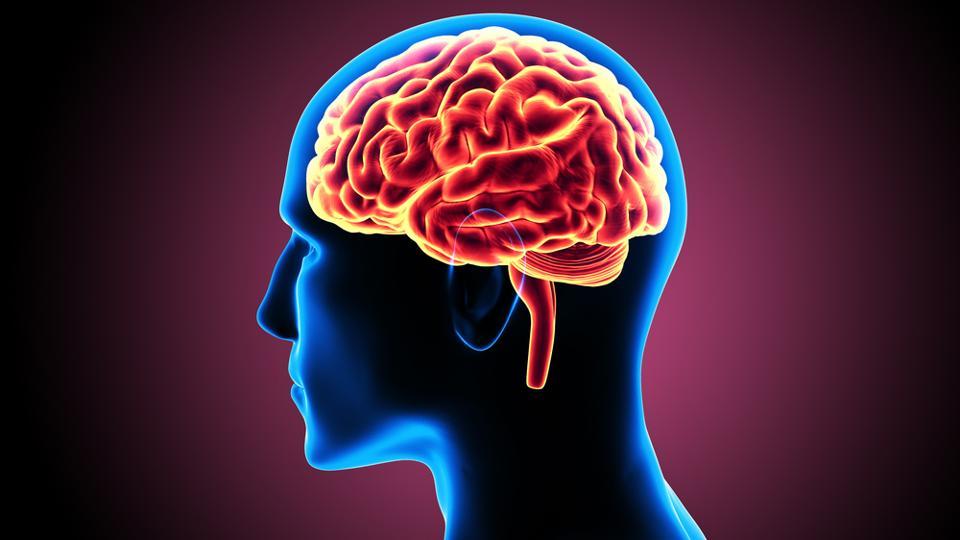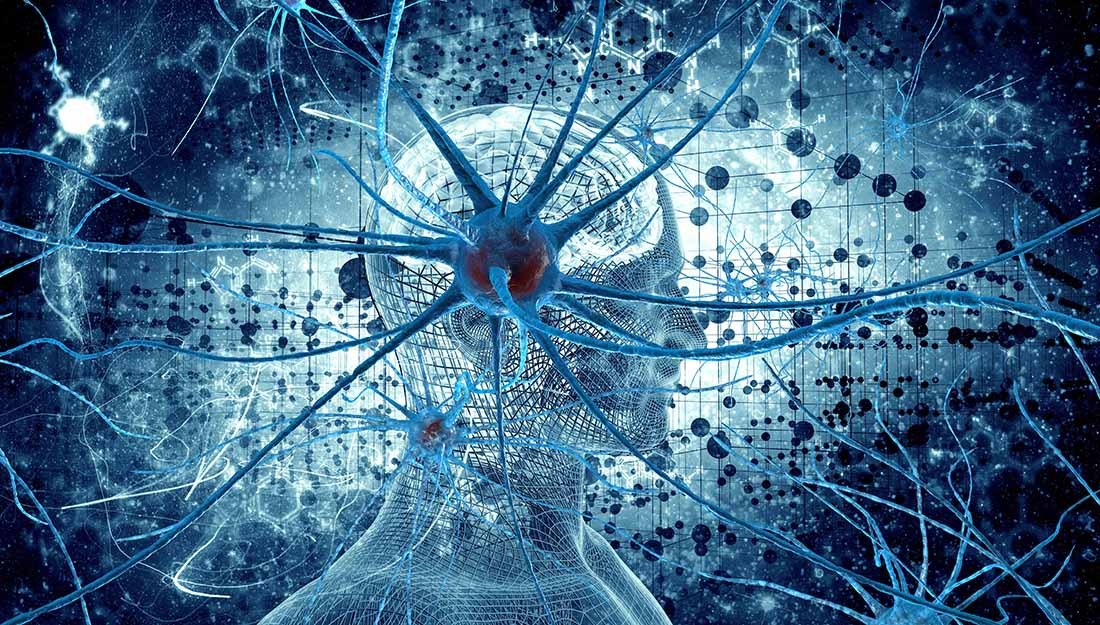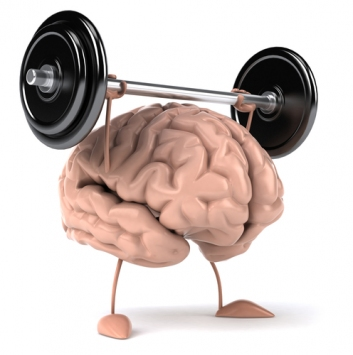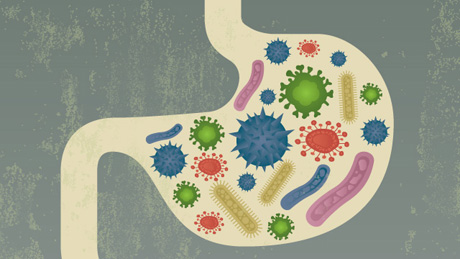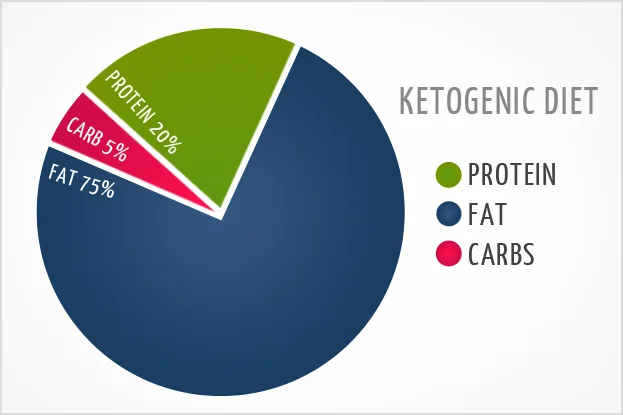Without a doubt, healthy blood flow is absolutely essential for optimal brain function and mental health.
Brain blood flow, or cerebral blood flow, refers to the blood supply that reaches your brain during a given period of time.
Your brain needs almost 20% of the blood supply provided by each heartbeat.
A steady flow of blood brings oxygen, glucose and nutrients to the brain, and carries carbon dioxide, lactic acid, and other metabolic waste products away from the brain.
But when blood flow to the brain is hindered, cognitive problems can arise.
Poor brain blood flow and circulation are linked to a number of brain and mental illnesses, including:
Cognitive dysfunction and brain fog (131-132)
Chronic fatigue syndrome (140)
Dementia (133)
Parkinson’s Disease (134)
Alzheimer’s disease (135, 143)
Depression (136)
Post-traumatic stress disorder (PTSD) (137-139)
Anxiety (139)
Panic disorder (139)
Agoraphobia (139)
Traumatic brain injury (141-142)
Lyme disease (144)
“Increasing blood flow to the brain might be an effective therapeutic approach to prevent or treat Alzheimer’s.”
Some of the main causes of poor brain blood flow include abnormal blood pressure, poor circulation, low thyroid, infections, and stress (126-130).
Besides addressing these major causes, there are several ways to directly increase the amount of oxygen-rich blood that flows to your brain.
Researchers use neuroimaging techniques, such as functional magnetic resonance imaging (fMRI) and positron emission tomography (PET), to measure cerebral blood flow.
And they have found that the following 22 methods increase brain blood flow and circulation in humans.
After suffering multiple concussions, I had severe depression and brain fog. So I had no choice but to focus on optimizing brain blood flow and circulation.
Many of these methods have been helpful to me over the years.
If you want to naturally increase blood flow to your brain, continue reading to learn more.
1. Exercise
Exercise is one of the best and most accessible ways to increase brain blood flow and circulation.
Research shows that moderate exercise increases blood flow to the brain by as much as 15% (1).
And you don’t even need to work out intensely to increase blood flow to your brain.
Simply walking for 30 minutes at a brisk pace, three or four times each week, is good enough. That will get more blood and oxygen to your brain and you’ll reap the benefits (2).
In fact, the foot’s impact on the ground while walking sends pressure waves through the arteries, which sends more blood and oxygen to the brain (3).
“There are many studies that suggest that exercise improves brain function in older adults, but we don’t know exactly why the brain improves. Our study indicates it might be tied to an improvement in the supply of blood flow to the brain.”
Exercise has also been shown to protect against cognitive decline and dementia, promote neurogenesis, help reverse brain damage, and promote the regeneration of myelin.
So not surprisingly, exercise is recommended by many experts and it’s often their number one piece of advice for optimal brain health.
My usual advice is to find a sport or exercise routine that you enjoy, so that you’ll stick with it consistently.
2. Cold Exposure
Exposing yourself to cold temperatures can also help you get more blood flowing to your brain.
Research shows that putting your hand in ice water for one minute can significantly increase the speed of blood flow to the brain (6-8).
Researchers have also found that cooling the skin during upright tilting maintains the speed of blood flow to the brain (5).
Animal studies also show that cold exposure significantly increases cerebral blood flow (4).
I take a cold shower every day, and often go outside with minimal clothing in the winter to increase my blood flow and circulation.
You don’t have to do that right away though. You can take it one baby step at a time.
You can start out by finishing your next shower with just 30 seconds of cold water.
See how you feel, and then work your way up to longer.
It can be a bit painful, but you get used to it and the beneficial effects are worth it.
Another way to ease yourself into it is by sticking your face, hand or foot in ice cold water.
Cold exposure also stimulates the vagus nerve and supports the endocannabinoid system.
3. Sunlight
Research also shows that light stimulates brain blood flow and circulation.
Positron emission technology (PET) measures blood flow to specific areas of the brain.
In one study, researchers used PET scans to monitor cerebral blood flow in patients with season affective disorder (SAD) – before and after light therapy.
Before light therapy, the scans show that patients had reduced blood flow to the cerebral cortex, the “executive” part of the brain.
But after just a few days of light therapy, this part of the brain started to light up, indicating greater activity and increased blood flow (9).
But this isn’t just seen in depressed individuals.
Another study found that 10 minutes of light exposure can increase brain blood flow in healthy people (10).
Light therapy even increases brain blood flow in pre-term infants (11).
I personally get sunlight every day during the spring and summer months to support my brain health. It’s a simple way for me to increase blood flow to my brain every day.
Researchers have also found a positive correlation between Vitamin D levels and brain blood flow (94).
So I take a Vitamin D3 supplement during the winter months when there isn't enough sun.
It's important to test and monitor your Vitamin D levels before and after supplementing with it.
4. Ginkgo Biloba
Ginkgo Biloba is a plant that has been used for thousands of years to treat a number of health problems.
Today, it’s one of the most popular herbal supplements in the world.
Doctors even prescribe it in Germany!
It’s most commonly used to improve brain health.
Researchers have found that it increases cognitive function, and improves memory and attention in both healthy and unhealthy individuals. It even reduces the risk of dementia and Alzheimer’s disease (15).
These positive effects are mainly because it significantly increases blood flow to the brain and increases blood circulation in the brain (12-14).
Gingko biloba is included in the Optimal Brain supplement.
5. Low-Level Laser Therapy (LLLT)
Low-level laser therapy (LLLT), or photobiomodulation, is a treatment that uses red and infrared light to support brain function.
The treatment uses either low-power lasers or light-emitting diodes (LEDs) that emit red and infrared light.
The red and infrared light is applied to the brain, and it stimulates brain cells, helping them helping them function better.
Most doctors are clueless about LLLT; but not every doctor.
Dr. Norman Doidge, a physician who teaches at the University of Toronto here in Canada, discusses the amazing effects of LLLT in his book The Brain’s Way of Healing.
One way LLLT can help the brain is by increasing brain blood flow and circulation.
One study found that applying near infrared light to the forehead can help treat depression and anxiety (without side effects) by increasing frontal regional cerebral blood flow (49).
Another study saw improvement in brain blood flow in healthy elderly women (50).
Animal research has also found that light can be used to locally increase brain blood circulation (93).
I previously wrote about my experience with low-level laser therapy here.
I have used the Optimal 1000 Brain Photobiomodulation Therapy Light (Combo Red/NIR) and shine the red and infrared light directly on my forehead. It’s a simple way for me to quickly and naturally increase blood flow to the brain.
When I’m travelling and away from home, I take this smaller and more convenient device with me and shine it on my forehead.
I’ve also used the Vielight Neuro Duo, which is a transcranial-intranasal headset with 810 nm of near infrared light. It penetrates deeper into brain tissue and is absorbed better by the central nervous system. If you decide to try a Vielight device, you can use the coupon code JORDANFALLIS for a 10% discount
LLLT can also support thyroid function and mitochondria function and help with brain fog.
6. Vinpocetine
Vinpocetine is a compound from the Periwinkle plant.
It’s commonly used in Europe to treat cognitive decline, memory impairments, stroke recovery, and epilepsy.
Researchers have found that it increases brain blood flow in both healthy people and stroke victims.
The increase in brain blood flow leads to increased brain oxygen levels and energy production, reduced brain inflammation, and improved reaction time (16-25).
I took a vinpocetine supplement many years ago after my last concussion to increase blood flow to the brain and speed up my recovery. But I no longer need to take it.
7. Meditation
Meditation is my favourite relaxation technique and it's linked to increased blood flow in the brain.
In one study, 14 people with memory problems followed a simple 8-week meditation program. And researchers found a significant increase in blood flow to the prefrontal cortex (31).
Logical memory and verbal fluency also improved after training (31).
Another study showed that just five days of meditation (30 minutes each day) significantly enhanced brain blood flow (32).
I have used the Muse headband to meditate. It gives you real-time feedback while you meditate. That way, you know how well you are meditating. It makes meditating much more enjoyable.
I previously wrote about it here, and you can get it through the Muse website.
8. Resveratrol
Resveratrol is a beneficial antioxidant and anti-inflammatory compound.
Many people know that it’s found in grapes, red wine, raspberries and dark chocolate.
Resveratrol is known to help prevent the development of neurodegenerative diseases.
And researchers are starting to understand why.
Resveratrol can increase BDNF, help restore the integrity of the blood-brain barrier, and support your mitochondria.
But it can also help you quickly get more blood and oxygen flowing to your brain.
In one study, after taking either 250 or 500 milligrams of resveratrol, study participants experienced a dose-dependent increase in brain blood flow (26).
Even just 75 mg has been shown to increase brain circulation and cognition (27, 29).
And a recent study found that chronic resveratrol supplementation increases brain blood circulation in post-menopausal women, improving their cognition and mood (28, 30).
Resveratrol is included in this supplement.
9. Dark Chocolate
Most people love chocolate, and your brain loves it too.
Dark chocolate contains cocoa, which is known to improve blood flow.
It's one of my favourite foods, and it’s included in my Free Grocery Shopping Guide for Optimal Brain and Mental Health.
Research suggests that the flavonoids found in cocoa beans increase blood flow to key areas of the brain for two to three hours after eating them. And this leads to an improvement in cognitive performance and general alertness (33, 35).
“Certain food components like cocoa flavanols may be beneficial in increasing brain blood flow and enhancing brain function among older adults or for others in situations where they may be cognitively impaired, such as fatigue or sleep deprivation.”
One study found that flavanol-rich cocoa significant increases the speed of brain blood flow in healthy elderly people (34).
Another study found that drinking two cups of hot chocolate a day for 30 days was linked to improved blood flow to the brain and better memory (36).
Dark chocolate also increases BDNF and reduces cortisol.
It’s important to choose a type of dark chocolate with at least 70 percent cocoa.
10. Omega-3 Fatty Acids
Omega-3s fatty acids are the highest quality fats for the brain.
They are essential, meaning your body cannot create them and you have to get them from food or supplements.
Making sure you get more omega-3s is one of the most important actions you can take to support your brain and nervous system.
Many studies show that they significantly reduce brain inflammation; improve memory, mood and cognition; and protect against mild cognitive impairment, dementia and Alzheimer's disease.
They also naturally increase brain blood flow and circulation.
Research shows that higher omega-3 levels are significantly correlated with higher regional cerebral blood flow (37).
“This is very important research because it shows a correlation between lower omega-3 fatty acid levels and reduced brain blood flow to regions important for learning, memory, depression and dementia.”
And one study found that omega-3 supplementation, in comparison with placebo, significantly increased brain blood flow (38).
Omega-3 fatty acids are found in cold water fish such as salmon, black cod, sablefish, sardines and herring.
These foods are included in my Free Grocery Shopping Guide for Optimal Brain and Mental Health.
Unfortunately, most people don't consume enough of these foods.
So supplementing with krill oil should be considered.
Krill oil is a special kind of fish oil that readily crosses the blood-brain barrier. I’ve tried tons of fish oil supplements, and I recommend krill oil over all the others.
11. Acupuncture
Acupuncture is an alternative treatment that has been shown to increase brain blood flow and circulation.
In a randomized controlled trial, 17 post-stroke patients did acupuncture or sham acupuncture for 20 minutes.
The researchers found that the speed of blood flow to both hemispheres of the brain significantly increased during and after acupuncture treatment (39, 42).
Research has also shown that acupuncture can significantly improve cerebral blood flow and circulation in animals (40-41, 43).
I’m a really big fan of auricular acupuncture, which is when the needles are inserted into ear.
In my experience, ear acupuncture is more effective than regular acupuncture. I’m not sure why. I’ve just personally noticed more benefits from ear acupuncture.
I’d recommend trying to find an acupuncturist in your area who provides ear acupuncture.
Ear acupuncture really helped me the first time I weened off antidepressants. I was surprised.
At the end of each appointment, my practitioner would secure small black seeds on my ear.
I have also used an acupuncture mat at home to relax before bed.
Acupuncture also stimulates the vagus nerve.
12. Chewing Gum
Research reveals that chewing increases brain blood flow (44).
As a result, chewing can improve cognitive performance and brain function, including working and spatial memory. It also increases the level of arousal and alertness during a cognitive task (45).
If you chew gum, make sure it’s aspartame-free.
Chewing gum also reduces cortisol.
13. Acetyl-L-Carnitine (ALCAR)
Acetyl-L-carnitine (ALCAR) is an acetylated form of the amino acid carnitine.
It’s known to help reverse neurological decline by increasing levels of acetylcholine in the brain.
It’s often used as a brain booster by people of all ages because it support brain cells and increases alertness.
It’s also been shown to be very effective at alleviating chronic fatigue and improving mood by supporting mitochondrial function.
Considering all of this, it’s not too surprising that researchers have also found that it can enhance brain blood flow in people who have had a stroke (46-47).
ALCAR is included in the Optimal Brain supplement.
Make sure you read this article to learn more about the remarkable benefits of ALCAR.
14. Nitrates
Nitrates are both naturally-occurring compounds found in soil and plants.
High levels of nitrates are found in foods such as beets, celery, cabbage, spinach, and other leafy green vegetables.
These foods are included in my Free Grocery Shopping Guide for Optimal Brain and Mental Health.
Research shows that a nitrate-rich diet can increase blood flow to the frontal lobe of the brain, improving cognitive function and protecting against cognitive decline (51-52).
Beet juice is a particularly rich source of nitrates, and studies have found that it can help widen blood vessels and increase oxygen and blood flow to the brain (53-54, 56).
A double-blind, placebo-controlled trial even found that beet juice can improve cognitive performance by increasing brain blood flow (55).
“There have been several very high-profile studies showing that drinking beet juice can lower blood pressure, but we wanted to show that drinking beet juice also increases perfusion, or blood flow, to the brain. There are areas in the brain that become poorly perfused as you age, and that’s believed to be associated with dementia and poor cognition.”
I don’t really enjoy the taste, but every so often, I’ll drink beet juice during cognitively-demanding tasks.
15. Drink Less Coffee (Or Take Theanine)
Coffee is generally excellent for brain health. There is a lot of research showing it is very healthy and can be protective against dementia.
However, studies also show that if you want to get more blood flowing to your brain and within you brain, you’re better off avoiding or limiting caffeine.
Researchers have found that caffeine significantly reduces brain blood flow by 20 to 30% depending on the study and dosage (74-77).
The good news is that taking the amino acid theanine can reduce the negative brain blood flow effects of caffeine (78-79).
That’s why I often take a theanine supplement when I drink coffee.
Theanine is included in this anti-anxiety supplement.
I also often take breaks from drinking coffee to normalize brain blood flow and circulation.
Taking the herb rhodiola can make quitting caffeine much easier because it helps reduce withdrawal symptoms.
Lastly, you could also try supplementing with the whole coffee fruit, instead of just drinking coffee.
The coffee bean is usually separated from the coffee fruit for roasting. When this happens, the surrounding coffee fruit is then thrown away.
That’s a problem because the coffee fruit contains several healthy compounds not found in coffee beans themselves.
In fact, scientists have discovered that ingesting coffee fruit concentrate significantly increases brain function.
That’s why coffee fruit concentrate is included in Optimal Brain.
16. Piracetam
Piracetam is a “nootropic”, which means it’s a supplement that enhances cognition.
It provides a mild boost in brain function, and it’s regularly used in Europe, Asia and South America to treat cognitive impairment.
A meta-analysis found that piracetam improves general cognition when supplemented by people in a state of cognitive decline (84).
Research also shows that it can increase brain blood flow in humans and animals (85-91).
I used to take piracetam every day but I don’t need it at all anymore.
Phenylpiracetam is an advanced version of piracetam and I found it to be even better because it improves mood and reduces anxiety. It’s also been shown to reverse the depressant effects of benzodiazepines (81-83).
Both piracetam and phenylpiracetam work best if you take them with a source of choline, such as CDP-Choline and Alpha GPC (80).
17. Ketogenic Dieting
A ketogenic diet is a very low-carbohydrate diet.
To follow the diet correctly, you need to eat less than 50 grams of carbohydrates per day.
This means you need to avoid all carbohydrate-rich foods, including grains, sugar, and even potatoes, legumes and fruit.
When you restrict carbs this much, your body enters ketosis, a metabolic state in which your body and brain run on fatty acids and “ketones” instead of glucose.
Researchers have found that ketones are a therapeutic option in traumatic brain injury because they can increase brain blood flow by 39% (100).
Studies have also shown that ketones increase cerebral blood flow by 65% in animals (103-104).
Caloric restriction also increases ketones, which preserves cerebral blood flow in aging rats (102).
I follow a ketogenic diet every so often, but not for long stretches of time due to hormone problems that can result from it.
18. Citicoline
Citicoline (also known as CDP-Choline) is one of the most bioavailable forms of choline.
You need to get choline from food. But most people don’t get enough because very few foods in the Western diet contain it.
That’s why supplementation is often necessary.
Citicoline is a supplemental form of choline that has anti-inflammatory and neuroprotective effects.
It enhances the synthesis of acetylcholine and dopamine (two neurotransmitters that are critical for optimal brain function) and increases the number of acetylcholine and dopamine receptors in your brain (105-110).
It’s also been shown to improve cognitive function by increasing the rate of brain blood flow (114-116).
A double-blind placebo-controlled study concluded that Citicoline improves cognitive performance in patients with Alzheimer’s disease by increasing brain blood flow (113).
I found that citicoline improved my focus and mental energy. It's included in the Optimal Brain supplement.
You can also find some choline in foods such as beef liver and egg yolks. These foods are included in my Free Grocery Shopping Guide for Optimal Brain and Mental Health.
But the effects of Citicoline are much more noticeable and immediate because it quickly passes the blood-brain barrier and supports your brain.
Citicoline also promotes the regeneration of myelin, supports the blood-brain barrier, and helps reverse brain damage.
Make sure you read this article to learn more about the remarkable benefits of Citicoline.
19. Blueberry Juice
Drinking blueberry juice improves cognitive function in the elderly, according to research published (123-125).
One way it improved brain health was by increasing oxygen levels and increasing blood flow to the brain.
The participants had improvements in working memory while doing cognitive testing.
“In this study we have shown that with just 12 weeks of consuming 30ml of concentrated blueberry juice every day, brain blood flow, brain activation and some aspects of working memory were improved in this group of healthy older adults.”
The amount of juice in the study was equivalent to 230g of blueberries.
The researchers believe that the flavonoids in blueberries were responsible for the positive effects.
20. Pyrroloquinoline Quinone (PQQ)
Pyrroloquinoline quinone (PQQ) is a vitamin-like enzyme and potent antioxidant found in plant foods that can improve cognitive function.
Researchers have found that supplementing with PQQ can increase blood flow to the prefrontal cortex (117-118).
One study found that PQQ can prevent the reduction of brain function in elderly people, especially in attention and working memory, by increasing brain blood flow (119).
21. Intranasal Insulin
Insulin is one of the hormones that significantly affects brain function.
It's been shown to pass the blood-brain barrier and act on insulin receptors directly within the brain.
In a new therapeutic approach, commercially-available insulin (Novalin R) is prepared and added to nasal spray bottles, and sprayed and inhaled through the nose to support brain and mental health.
Intranasal insulin has been reported to significantly enhance memory, increase mental energy, reduce brain fog, improve mood, and lower anxiety and stress levels.
One possible mechanism is by increasing brain blood flow and circulation.
Research shows that intranasal insulin increases regional cerebral blood flow in the insular cortex (120, 122).
In a randomized, double-blinded, placebo-controlled, intranasal insulin improved brain blood flow in older adults (121).
If you’re interested in learning more, I previously wrote a full article about intranasal insulin.
22. Music
I previously wrote about how music naturally reduces cortisol, helps treat OCD, and increases dopamine and oxytocin.
But now it looks like it also increases blood flow to the brain.
Researchers found that musical training or listening to music increases blood flow to the brain (145-146).
It’s even more effective when you’re learning or listening to music that you really enjoy.
23. BONUS: Other Promising Nutrients and Herbs
Researchers have found that the following compounds can increase cerebral blood flow in animals. But I couldn’t find any research showing that it will do the same in humans. However, they are worth experimenting with as many of them have been effective at supporting my brain and mental health over the years.
Arginine (57-60)
Vitamin E (61-64)
Bacopa (65-66) – also improves memory
Curcumin (67-68)
Ginseng (69-70)
Citrulline (71-72)
Icariin (73) – also promotes neurogenesis
Forskolin (95) – also helps with brain fog
S-adenosyl-L-methionine (96)
Quercetin (97-98)
Taurine (99) – also lowers homocysteine
Enjoy This Article? You Might Also Like My FREE Food Guide for Optimal Brain and Mental Health!
References:
(1) http://www.the-aps.org/mm/hp/Audiences/Public-Press/Archive/2011/9.html
(2) https://www.sciencedaily.com/releases/2011/04/110412131921.htm
(3) http://www.nmhu.edu/research-shows-walking-increases-blood-flow-brain/
(4) https://www.ncbi.nlm.nih.gov/pubmed/754495
(5) https://www.ncbi.nlm.nih.gov/pubmed/12070190
(6) https://www.ncbi.nlm.nih.gov/pubmed/8706113
(7) https://www.ncbi.nlm.nih.gov/pubmed/22104537
(8) https://www.ncbi.nlm.nih.gov/pubmed/27206903
(10) https://www.ncbi.nlm.nih.gov/pmc/articles/PMC3819153/
(11) http://onlinelibrary.wiley.com/doi/10.1111/j.1469-8749.2004.tb00460.x/abstract
(12) https://www.ncbi.nlm.nih.gov/pubmed/12905098
(13) http://www.ncbi.nlm.nih.gov/pubmed/25966264
(14) https://www.ncbi.nlm.nih.gov/pmc/articles/PMC3163160/
(15) https://www.ncbi.nlm.nih.gov/pmc/articles/PMC3679686/
(16) https://examine.com/supplements/vinpocetine/
(17) https://www.ncbi.nlm.nih.gov/pubmed/15760651
(18) https://www.ncbi.nlm.nih.gov/pubmed/12498034
(19) https://www.ncbi.nlm.nih.gov/pubmed/12460136
(20) https://www.ncbi.nlm.nih.gov/pmc/articles/PMC1429914/
(21) https://www.ncbi.nlm.nih.gov/pubmed/12044859
(22) https://www.ncbi.nlm.nih.gov/pmc/articles/PMC4274818/
(23) https://www.ncbi.nlm.nih.gov/pubmed/23289173
(24) https://www.ncbi.nlm.nih.gov/pubmed/25548768
(25) https://www.ncbi.nlm.nih.gov/pubmed/19135345
(26) https://www.ncbi.nlm.nih.gov/pubmed/20357044
(27) https://www.ncbi.nlm.nih.gov/pubmed/27105868
(28) https://www.ncbi.nlm.nih.gov/pubmed/28054939
(29) https://www.ncbi.nlm.nih.gov/pubmed/27420093
(30) https://www.ncbi.nlm.nih.gov/pubmed/27005658
(31) https://www.ncbi.nlm.nih.gov/pubmed/20164557
(32) http://journal.frontiersin.org/article/10.3389/fpsyg.2015.00212/full
(33) http://www.medsci.org/press/cocoa.html
(34) https://www.ncbi.nlm.nih.gov/pmc/articles/PMC2518374/
(35) https://www.ncbi.nlm.nih.gov/pubmed/16794461
(36) https://www.eurekalert.org/pub_releases/2013-08/aaon-cmh073113.php
(37) https://www.ncbi.nlm.nih.gov/pubmed/28527220
(38) http://www.sciencedirect.com/science/article/pii/S0301051111002584
(39) https://www.ncbi.nlm.nih.gov/pubmed/26569545
(40) https://www.ncbi.nlm.nih.gov/pubmed/19358505
(41) http://journals.plos.org/plosone/article?id=10.1371/journal.pone.0056736
(43) https://www.ncbi.nlm.nih.gov/pubmed/24006668
(44) https://www.ncbi.nlm.nih.gov/pubmed/9134116
(45) http://www.medsci.org/v11p0209.htm
(46) https://www.ncbi.nlm.nih.gov/pubmed/2068049
(47) https://www.ncbi.nlm.nih.gov/pubmed/2387659
(48) http://www.sciencedirect.com/science/article/pii/S1673537407600383
(49) https://www.ncbi.nlm.nih.gov/pubmed/19995444
(50) https://www.ncbi.nlm.nih.gov/pubmed/25277249
(51) https://www.ncbi.nlm.nih.gov/pmc/articles/PMC3575935/
(52) http://www.webmd.com/brain/news/20101103/beet-juice-good-for-brain#1
(54) http://www.webmd.com/brain/news/20101103/beet-juice-good-for-brain#1
(55) https://www.ncbi.nlm.nih.gov/pubmed/26037632
(56) https://www.ncbi.nlm.nih.gov/pubmed/27630836
(57) https://www.ncbi.nlm.nih.gov/pubmed/16912655
(58) https://www.ncbi.nlm.nih.gov/pubmed/17459424
(59) https://www.ncbi.nlm.nih.gov/pubmed/12614590
(60) http://www.sciencedirect.com/science/article/pii/S0026286207000258
(61) http://onlinelibrary.wiley.com/doi/10.1002/ana.410150507/abstract
(62) https://www.sciencedaily.com/releases/2014/04/140429085116.htm
(64) http://journals.sagepub.com/doi/abs/10.1038/jcbfm.2011.85
(65) https://www.ncbi.nlm.nih.gov/pmc/articles/PMC3746283/
(66) https://www.ncbi.nlm.nih.gov/pubmed/22447676
(67) http://www.sciencedirect.com/science/article/pii/S0024320509004627
(68) https://www.ncbi.nlm.nih.gov/pubmed/19925811
(69) https://www.ncbi.nlm.nih.gov/pubmed/12466053
(71) https://www.ncbi.nlm.nih.gov/pubmed/23685189
(72) https://www.ncbi.nlm.nih.gov/pubmed/28325558
(74) https://www.ncbi.nlm.nih.gov/pmc/articles/PMC2748160/
(75) https://www.ncbi.nlm.nih.gov/pubmed/15132312/
(76) https://www.ncbi.nlm.nih.gov/pubmed/2122148/
(77) https://www.ncbi.nlm.nih.gov/pmc/articles/PMC3677118/
(78) https://www.ncbi.nlm.nih.gov/pmc/articles/PMC4480845/
(79) https://www.ncbi.nlm.nih.gov/pubmed/25761837
(80) https://www.ncbi.nlm.nih.gov/pubmed/7301036
(81) https://link.springer.com/article/10.2165/11319230-000000000-00000
(82) https://www.ncbi.nlm.nih.gov/pubmed/21689376
(83) https://www.ncbi.nlm.nih.gov/pubmed/6403074
(84) https://examine.com/supplements/piracetam/
(85) https://www.ncbi.nlm.nih.gov/pubmed/3556550
(86) https://www.ncbi.nlm.nih.gov/pubmed/21183904
(88) https://www.ncbi.nlm.nih.gov/pubmed/4026900
(89) https://www.ncbi.nlm.nih.gov/pubmed/8876930
(90) https://www.ncbi.nlm.nih.gov/pubmed/10978039
(91) https://www.ncbi.nlm.nih.gov/pubmed/17523446
(93) https://www.nature.com/articles/ncomms14191
(94) https://www.ncbi.nlm.nih.gov/pubmed/22773150
(95) https://www.ncbi.nlm.nih.gov/pubmed/3810733
(96) https://www.ncbi.nlm.nih.gov/pubmed/3446252
(97) https://www.ncbi.nlm.nih.gov/pubmed/20096732
(99) https://www.ncbi.nlm.nih.gov/pubmed/27156064
(100) https://www.ncbi.nlm.nih.gov/pubmed/8967461
(101) https://ccforum.biomedcentral.com/articles/10.1186/cc10020
(102) https://goo.gl/KRZ9oy
(103) https://www.ncbi.nlm.nih.gov/pubmed/16001018
(104) http://journals.sagepub.com/doi/full/10.1038/sj.jcbfm.9600177
(105) http://www.ncbi.nlm.nih.gov/pmc/articles/PMC2695184/
(106) http://www.ncbi.nlm.nih.gov/pubmed/11796739
(107) http://www.ncbi.nlm.nih.gov/pmc/articles/PMC1430829/
(108) https://www.ncbi.nlm.nih.gov/pubmed/1839138
(109) https://www.ncbi.nlm.nih.gov/pubmed/1098982
(110) http://www.ncbi.nlm.nih.gov/pubmed/19351232
(111) http://www.ncbi.nlm.nih.gov/pmc/articles/PMC4011061/
(112) https://www.ncbi.nlm.nih.gov/pubmed/16055952
(113) https://www.ncbi.nlm.nih.gov/pubmed/10669911
(114) https://www.ncbi.nlm.nih.gov/pubmed/1098982
(115) https://www.ncbi.nlm.nih.gov/pubmed/7820960
(116) https://www.ncbi.nlm.nih.gov/pubmed/7913981/
(117) https://link.springer.com/chapter/10.1007/978-3-319-38810-6_29
(118) https://www.ncbi.nlm.nih.gov/pubmed/27526146
(119) https://www.ncbi.nlm.nih.gov/pubmed/26782228
(120) https://www.ncbi.nlm.nih.gov/pubmed/23907764
(121) https://www.ncbi.nlm.nih.gov/pmc/articles/PMC5391232/
(122) http://onlinelibrary.wiley.com/doi/10.1002/hbm.22304/abstract
(123) https://www.ncbi.nlm.nih.gov/pubmed/28249119
(124) http://www.exeter.ac.uk/news/featurednews/title_572581_en.html
(125) https://www.sciencedaily.com/releases/2017/03/170307100356.htm
(126) https://www.ncbi.nlm.nih.gov/pubmed/20453669
(127) https://www.ncbi.nlm.nih.gov/pmc/articles/PMC3539653/
(128) https://www.ncbi.nlm.nih.gov/pmc/articles/PMC3246784/
(129) https://www.ncbi.nlm.nih.gov/pubmed/15118175
(130) https://www.ncbi.nlm.nih.gov/pubmed/14757593
(131) https://www.ncbi.nlm.nih.gov/pubmed/28155036
(132) https://www.ncbi.nlm.nih.gov/pubmed/28506213
(133) https://www.ncbi.nlm.nih.gov/pubmed/15929050
(134) https://www.ncbi.nlm.nih.gov/pubmed/17088679
(135) https://www.ncbi.nlm.nih.gov/pubmed/10867218
(136) https://www.ncbi.nlm.nih.gov/pubmed/9682941
(137) http://jamanetwork.com/journals/jamapsychiatry/fullarticle/481961
(138) https://www.ncbi.nlm.nih.gov/pubmed/12742675
(139) https://www.ncbi.nlm.nih.gov/pubmed/9373423
(140) https://www.ncbi.nlm.nih.gov/pubmed/21167506
(141) https://www.ncbi.nlm.nih.gov/pubmed/7496746
(142) https://www.ncbi.nlm.nih.gov/pubmed/1919689
(143) http://neuro.psychiatryonline.org/doi/abs/10.1176/jnp.15.3.326
(144) http://jamanetwork.com/journals/jamaneurology/fullarticle/783869
(145) https://www.sciencedaily.com/releases/2017/04/170412181341.htm

